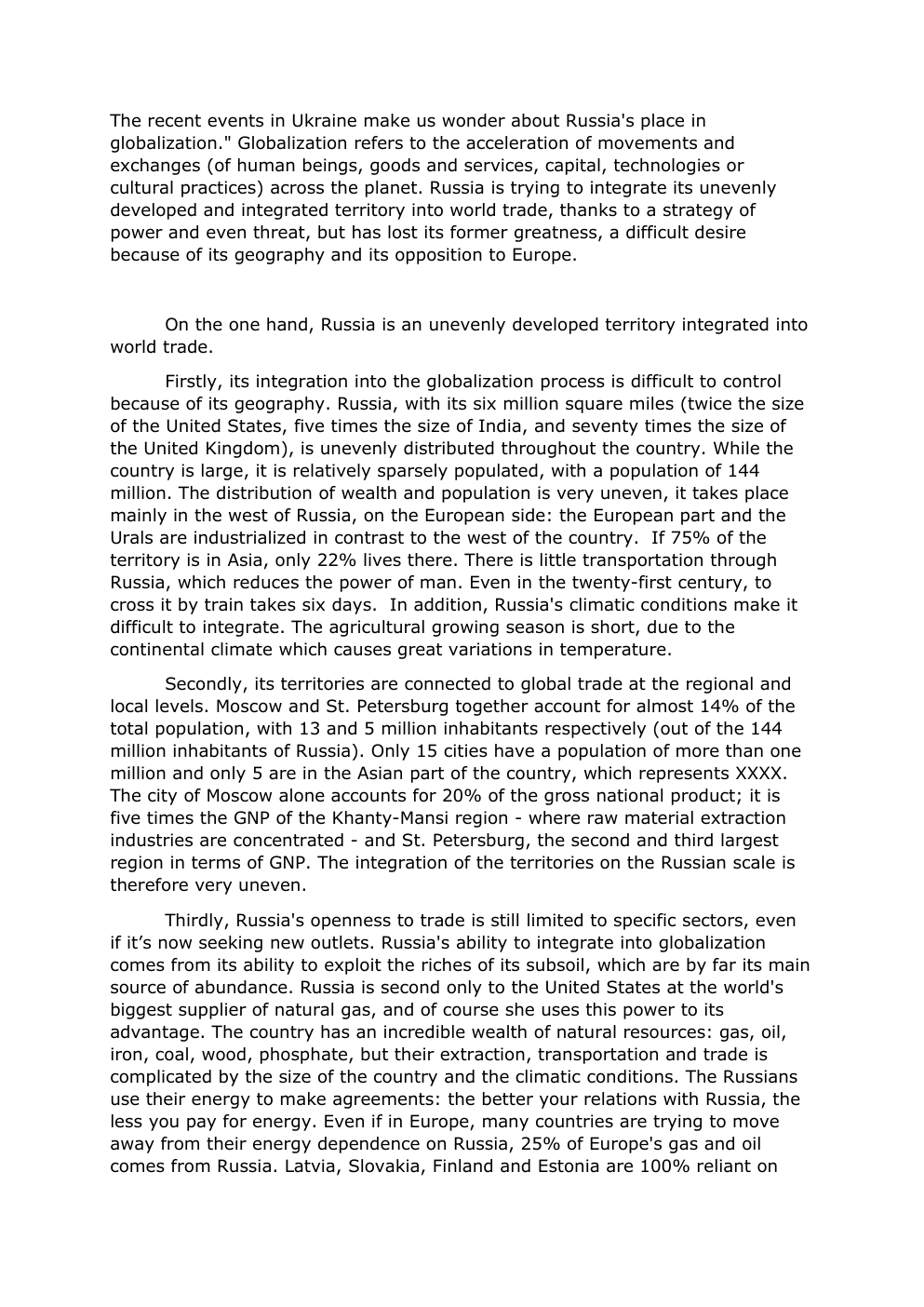la russie dans la globalisation
Publié le 21/11/2022

Extrait du document
«
The recent events in Ukraine make us wonder about Russia's place in
globalization." Globalization refers to the acceleration of movements and
exchanges (of human beings, goods and services, capital, technologies or
cultural practices) across the planet.
Russia is trying to integrate its unevenly
developed and integrated territory into world trade, thanks to a strategy of
power and even threat, but has lost its former greatness, a difficult desire
because of its geography and its opposition to Europe.
On the one hand, Russia is an unevenly developed territory integrated into
world trade.
Firstly, its integration into the globalization process is difficult to control
because of its geography.
Russia, with its six million square miles (twice the size
of the United States, five times the size of India, and seventy times the size of
the United Kingdom), is unevenly distributed throughout the country.
While the
country is large, it is relatively sparsely populated, with a population of 144
million.
The distribution of wealth and population is very uneven, it takes place
mainly in the west of Russia, on the European side: the European part and the
Urals are industrialized in contrast to the west of the country.
If 75% of the
territory is in Asia, only 22% lives there.
There is little transportation through
Russia, which reduces the power of man.
Even in the twenty-first century, to
cross it by train takes six days.
In addition, Russia's climatic conditions make it
difficult to integrate.
The agricultural growing season is short, due to the
continental climate which causes great variations in temperature.
Secondly, its territories are connected to global trade at the regional and
local levels.
Moscow and St.
Petersburg together account for almost 14% of the
total population, with 13 and 5 million inhabitants respectively (out of the 144
million inhabitants of Russia).
Only 15 cities have a population of more than one
million and only 5 are in the Asian part of the country, which represents XXXX.
The city of Moscow alone accounts for 20% of the gross national product; it is
five times the GNP of the Khanty-Mansi region - where raw material extraction
industries are concentrated - and St.
Petersburg, the second and third largest
region in terms of GNP.
The integration of the territories on the Russian scale is
therefore very uneven.
Thirdly, Russia's openness to trade is still limited to specific sectors, even
if it’s now seeking new outlets.
Russia's ability to integrate into globalization
comes from its ability to exploit the riches of its subsoil, which are by far its main
source of abundance.
Russia is second only to the United States at the world's
biggest supplier of natural gas, and of course she uses this power to its
advantage.
The country has an incredible wealth of natural resources: gas, oil,
iron, coal, wood, phosphate, but their extraction, transportation and trade is
complicated by the size of the country and the climatic conditions.
The Russians
use their energy to make agreements: the better your relations with Russia, the
less you pay for energy.
Even if in Europe, many countries are trying to move
away from their energy dependence on Russia, 25% of Europe's gas and oil
comes from Russia.
Latvia, Slovakia, Finland and Estonia are 100% reliant on
Russian gas; half of Germany's gas supply comes from Russia.
But the Russian
economy is also trying to diversify with agriculture for example.
Agriculture
represents 3.1% of Russian GDP (source: French Ministry of Agriculture and Food
Sovereignty).
It is the fifth largest exporter of grain in 2017-2018 with 45 million
tons.
Its goal is to export 50 million tons within 10 to 15 years, which is 20% of
the world market.
Since 2017, Russia is also the first world exporter of wheat.
On the other hand, Russia is today in a power strategy that articulates
economic cooperation but also threats on its neighbors.
Firstly at the diplomatic and military level, Russia is developing a strategy
of power and influence, on its borders, but also further away in the
Mediterranean.
There was a time when Russia, through the USSR, ruled a part of
the world: the time of the Cold War, when two superpowers, the American and
the Soviet, competed for influence.
When the USSR collapsed in 1991, Russia
presented itself as the....
»
↓↓↓ APERÇU DU DOCUMENT ↓↓↓
Liens utiles
- la place du gaz dans le conflit Ukraine/russie
- La puissance de la Russie sous Poutine
- Sujet : Vers une coopération internationale pour résoudre le conflit Ukraine Russie
- UN ÉTAT ET UN ESPACE EN RECOMPOSITION : LA RUSSIE
- Russie (2000-2001): Une opposition introuvable


